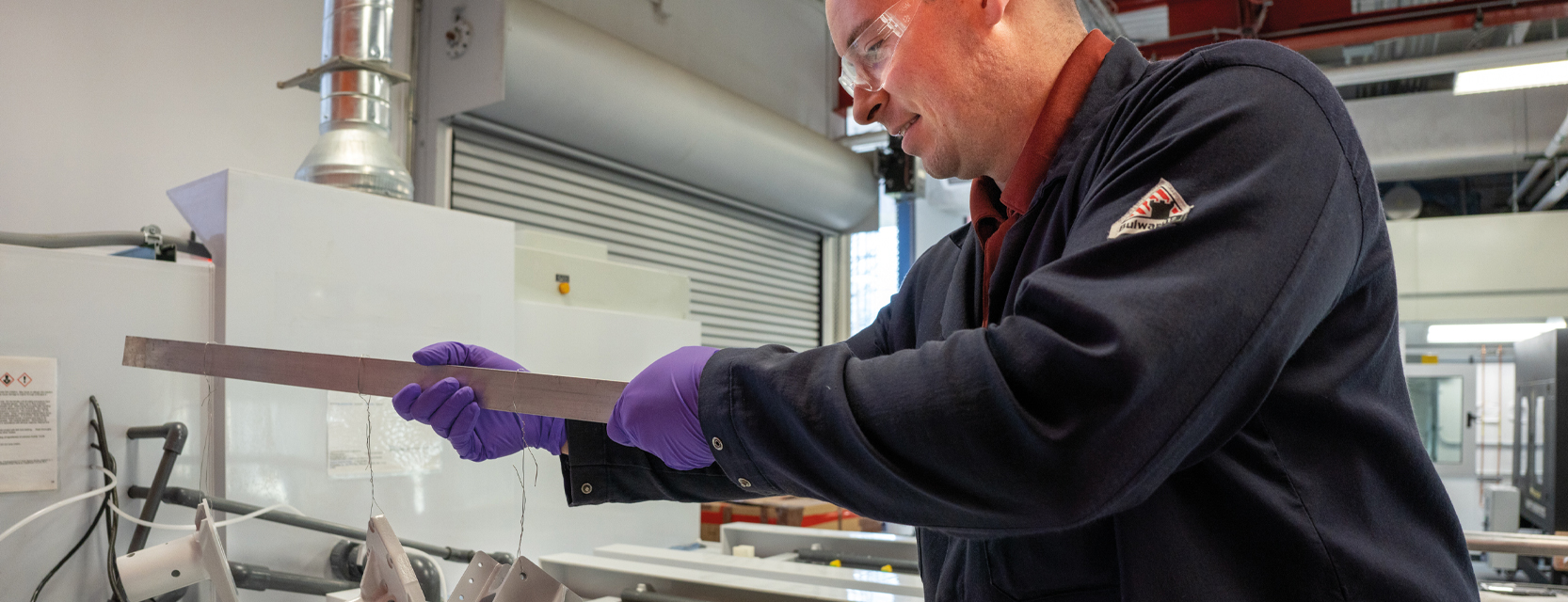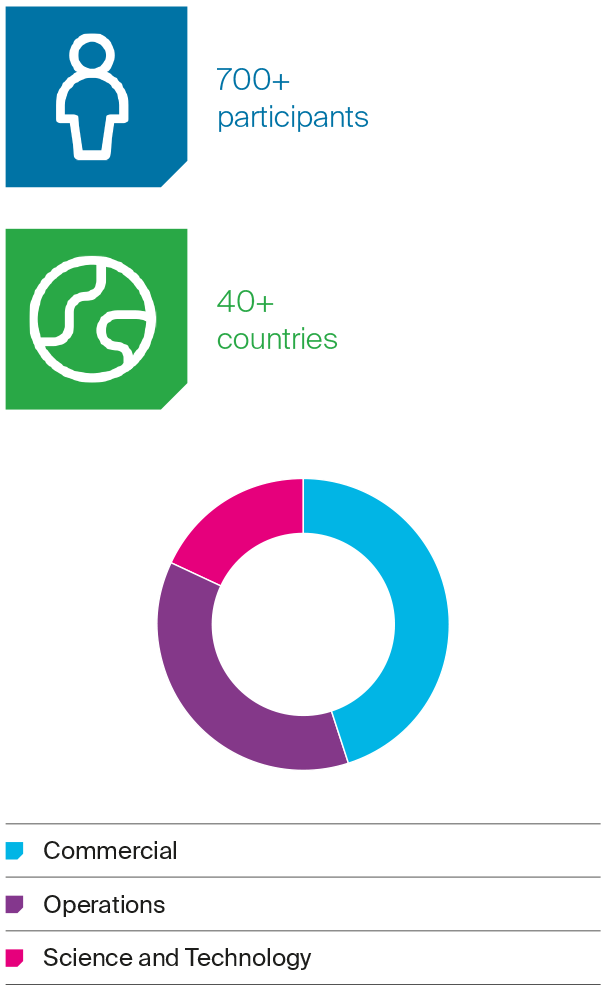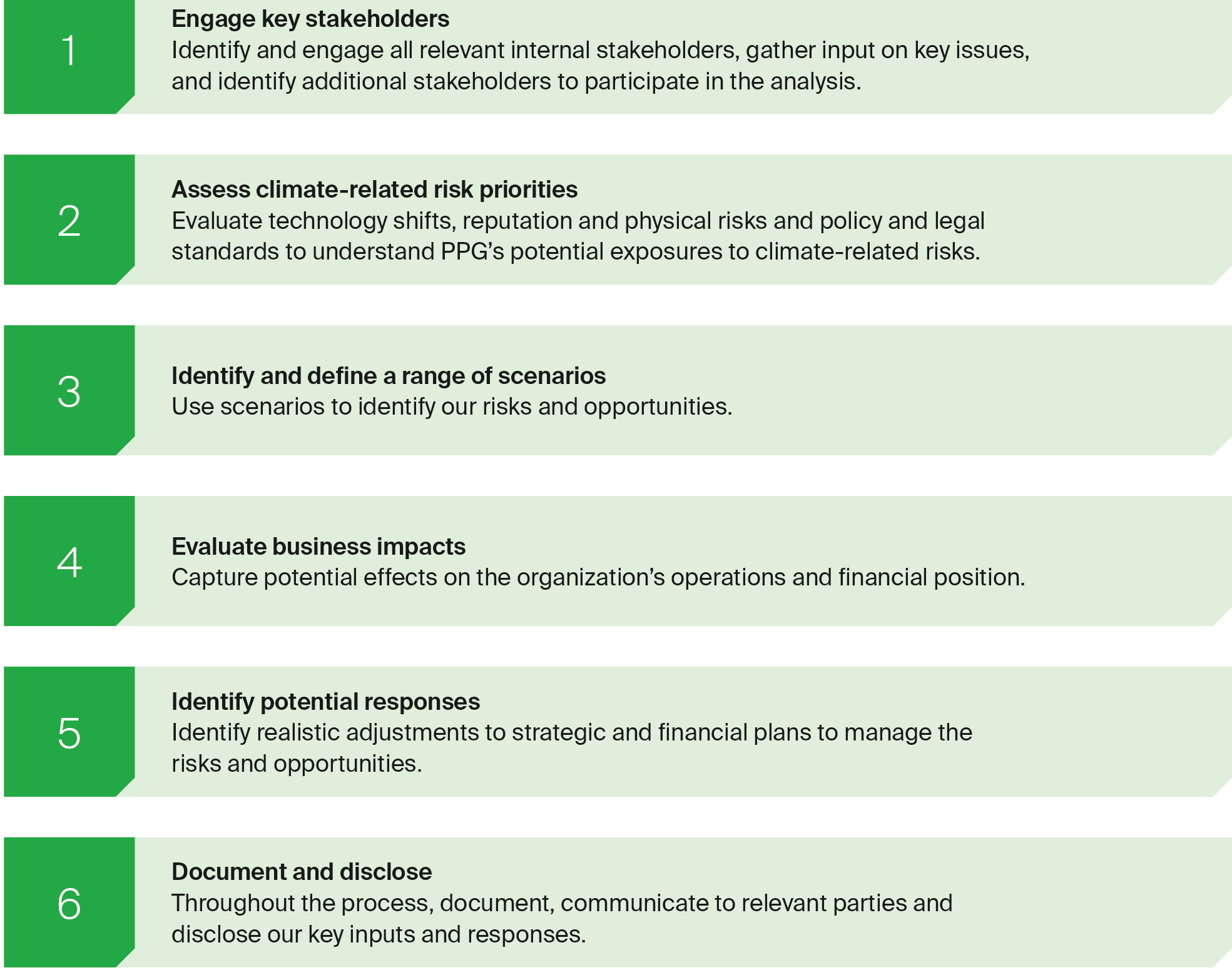ESG Report
Climate-Related Risks

We use a systematic approach to manage climate risks
Climate change is one of the most pressing global issues today, threatening the livelihood of billions of people now and in future generations. From extreme weather to continued environmental degradation, the effects of global warming are felt across all regions and industries.
At PPG, we seek to protect and beautify the world. We couldn't achieve this mission without committing to do our part to combat climate change. And we are doing this across our value chain—from the sustainability standards we set for our suppliers, to efforts to reduce our own internal environmental footprint, to the solutions we provide for our customers that in turn help them pursue their environmental objectives.
We have a global manufacturing footprint and are committed to continuing our efforts to reduce the environmental impacts of our PPG operations. We will continue to focus on the actions necessary to improve our resource efficiency and operate our facilities sustainably. To that end, we have set sustainability targets to reduce energy, waste, water and greenhouse gas emissions. We are focused on energy efficiency actions and increasing our renewable electrical energy sourcing to drive down greenhouse gas emissions thereby reducing the impact on the earth's climate. By committing to set Science-Based Targets and seeking to better understand our Scope 3 emissions, we are making headway as we continue to reduce our impact across our supply chain.
To expand our understanding and refine actions related to climate change, PPG proactively undertakes planning and scenario analysis. We performed scenario analyses in 2021 to evaluate broad risks and opportunities to our business associated with climate change and have incorporated those evaluations into the business risk and planning process. The program reflects guidance from the Task Force on Climate Related Disclosures (TCFD) and resulted in a high-level, qualitative perspective on climate change stressors with potential to affect PPG's global portfolio of facilities. We continue to build on these efforts by assessing and prioritizing sites with the greatest climate risk impacts and depending on forecasted climate impact timing, defining resiliency planning actions to ensure sites are prepared.
Our products, processes and innovations can also help consumers live more sustainably and help industries reduce their impact on the planet. We also continue to pursue supplier management strategies that help us make more sustainable choices in what we buy and from whom. Creating sustainably advantaged products and supporting more responsible processes along our supply chain are just a few of our tools to combat climate change over the long term.
Overview of Climate Risks And Opportunities And How We Are Addressing Them |
||||||||
|---|---|---|---|---|---|---|---|---|
| Risk / Opportunity | Climate Change Risk Type | Issue | Potential Impact | Optimizing the efficiency of our operations and logistics | Climate change impact facility assessments | Increasing the use of renewable energy | Supplier sustainability initiatives | Increase in sustainably advantaged products and services |
|
Risk |
Physical |
Increase severity and frequency of severe weather |
Disruption to supply chain and manufacturing locations |
X |
X |
|
X |
|
|
Risk |
Transition |
Increased government regulation and carbon pricing |
Increased operating costs |
X |
|
X |
|
|
|
Opportunity |
Transition |
Transition to Lower Carbon Economy |
PPG products designed for the low carbon markets (EVs, energy storage, Green Buildings) |
|
|
X |
|
X |
|
Opportunity |
Transition |
Increased Sustainability Demands from Customer |
PPG products that allow our customers to meet their climate goals |
|
|
|
|
X |
|
Opportunity |
Transition |
Shift in consumer preferences |
PPG products that provide consumers with a low carbon choice |
|
|
|
|
X |
Evaluating Climate Risks and Opportunities
To address the physical risks associated with climate change, we maintain systematic emergency and crisis management processes. Through these processes, we coordinate the efforts of our local emergency management teams at each location with our regional and global crisis management leadership.
Global, regional and local plans consider the risk of natural disaster, infectious disease, supply chain interruptions, employee safety, asset protection, customer impacts and other business continuity requirements. As one example, we implemented plans in 2021 to manage the hurricanes that impacted our facility in Lake Charles, Louisiana.
Each year, the local emergency management team at each of our facilities around the world must review and update its emergency response plan to reflect current conditions and changes in risk. Each site also performs an emergency response exercise, and our global leadership monitors conformance with these requirements through our internal corporate auditing processes. In addition, our regional and global crisis management teams conduct similar crisis response exercises annually.
Beyond physical risks, we also evaluate the potential impact of climate change risks on regulatory, legal, technology, market and reputational issues.
Climate Scenario Analysis: Assessing Risks and Opportunities Over the Longer Term

In 2021, we initiated a broader assessment using the Task Force for Climate-Related Financial Disclosure (TCFD) framework, we evaluated six transitional risks and four physical risks to identify significant impacts and opportunities related to climate change, with the business incorporating the results into its annual strategic planning process. We used the IEA Sustainable Development scenario and the Inevitable Policy Response Forecast Policy Response scenario for transition risks and the IPPC RCP 8.5 and RCP 6.0 scenario for physical risks. The assessment included 700 participants representing all business units in 40 countries and multiple functions including commercial, operations and science and technology.
Feedback was entirely qualitative and will be reviewed and considered as each business conducts an annual strategy review. Additional work is needed to better understand the overall risks and business opportunities as a result of climate change.
Building on the TCFD climate change analysis we started in 2021, we continue to work to identify and analyze potential climate impacts, in particular physical risks. In the first of a two-phase plan, we developed a Global Portfolio Climate Change Risk Assessment which includes over 250 PPG locations around the world. With a third party, we used global climate models to assess the relative risk of each facility against six climate change stressors: drought, flooding potential, extreme heat, extreme seasonal precipitation, sea-level rise and high wind speeds.
Using an interactive dashboard developed from the assessment, we can further explore these results, evaluate the climate risks for all sites and filter by type of risk, business unit, region, country and type of facility. Through these filters, we can conduct a deeper scenario analysis as far as the year 2100. This assessment will allow us to better understand and plan for potential physical risks associated with climate change, for example, by investing in our facilities. With this work, we can build resiliency that addresses the specific climate risk from the assessment.
We will expand our analysis of potential risks and opportunities to include a quantitative evaluation of our global enterprise. This analysis will be broader in scope and incorporate location-level data as well as data about our facilities.
Our Climate Change Scenario Analysis Process
To identify how we can reach our goals and adapt to the changing climate, we follow the TCFD's recommended guidance to conduct a climate change scenario analysis. Those steps are as follows:

Developing New Products to Respond to Climate Risks and Opportunities
Climate change presents not only risks but also opportunities to develop sustainably advantaged products that help our customers reduce their environmental footprint, among other benefits. By continuing to develop sustainably advantaged products and processes, we can move the needle on new solutions to tackling climate change while minimizing our own impact on the environment.
To identify and capture these opportunities, we conduct assessments of products in our existing portfolio while pursuing new product development initiatives that contribute positively to both climate change and the U.N. Sustainable Development Goals (SDGs), in particular SDG6 (Clean Water), SDG7 (Clean Energy), SDG12 (Sustainable Consumption) and SDG13 (Climate Change). These sustainable attributes also benefit our supply chain, operations, customers' sustainability and product end-of-life impact. See the Product Stewardship and Product Overview sections for additional information.
Advocating For The Planet
In addition to our internal and product development efforts, we seek to effect industry-wide change through our advocacy efforts.
Through our Government Affairs department and membership with trade associations and coalitions, we engage directly and indirectly on an ongoing basis with policymakers at the local, state and national levels on issues related to climate change. Two key focus areas are energy efficiency and clean energy generation.
We are a strong supporter of energy efficiency, innovation and sustainability. As such, we are supportive of bipartisan energy-efficiency legislation. We also support legislation on clean energy generation that provides manufacturers with access to a range of energy resources. We support an "all-of-the-above" approach to energy generation, which includes clean energy generation methods such as wind and solar. We believe that clean energy generation must occur in a measured way, without significant price fluctuations and without harming our production, suppliers and business customers.
As a producer of advanced coatings that go into clean energy generation, we closely follow the advanced energy manufacturing industry. We frequently support the advocacy efforts of wind, solar and other clean energy stakeholders.

